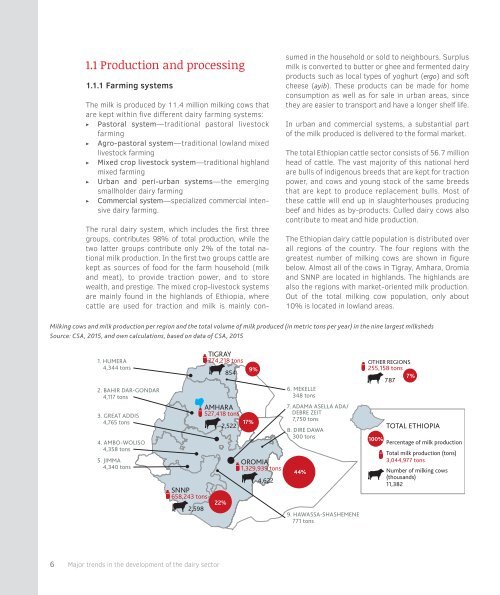Dairy sector
2DairyBOR
2DairyBOR
You also want an ePaper? Increase the reach of your titles
YUMPU automatically turns print PDFs into web optimized ePapers that Google loves.
1.1 Production and processing<br />
1.1.1 Farming systems<br />
The milk is produced by 11.4 million milking cows that<br />
are kept within five different dairy farming systems:<br />
▶ Pastoral system—traditional pastoral livestock<br />
farming<br />
▶ Agro-pastoral system—traditional lowland mixed<br />
livestock farming<br />
▶ Mixed crop livestock system—traditional highland<br />
mixed farming<br />
▶ Urban and peri-urban systems—the emerging<br />
smallholder dairy farming<br />
▶ Commercial system—specialized commercial intensive<br />
dairy farming.<br />
The rural dairy system, which includes the first three<br />
groups, contributes 98% of total production, while the<br />
two latter groups contribute only 2% of the total national<br />
milk production. In the first two groups cattle are<br />
kept as sources of food for the farm household (milk<br />
and meat), to provide traction power, and to store<br />
wealth, and prestige. The mixed crop-livestock systems<br />
are mainly found in the highlands of Ethiopia, where<br />
cattle are used for traction and milk is mainly consumed<br />
in the household or sold to neighbours. Surplus<br />
milk is converted to butter or ghee and fermented dairy<br />
products such as local types of yoghurt (ergo) and soft<br />
cheese (ayib). These products can be made for home<br />
consumption as well as for sale in urban areas, since<br />
they are easier to transport and have a longer shelf life.<br />
In urban and commercial systems, a substantial part<br />
of the milk produced is delivered to the formal market.<br />
The total Ethiopian cattle <strong>sector</strong> consists of 56.7 million<br />
head of cattle. The vast majority of this national herd<br />
are bulls of indigenous breeds that are kept for traction<br />
power, and cows and young stock of the same breeds<br />
that are kept to produce replacement bulls. Most of<br />
these cattle will end up in slaughterhouses producing<br />
beef and hides as by-products. Culled dairy cows also<br />
contribute to meat and hide production.<br />
The Ethiopian dairy cattle population is distributed over<br />
all regions of the country. The four regions with the<br />
greatest number of milking cows are shown in figure<br />
below. Almost all of the cows in Tigray, Amhara, Oromia<br />
and SNNP are located in highlands. The highlands are<br />
also the regions with market-oriented milk production.<br />
Out of the total milking cow population, only about<br />
10% is located in lowland areas.<br />
Milking cows and milk production per region and the total volume of milk produced (in metric tons per year) in the nine largest milksheds<br />
Source: CSA, 2015, and own calculations, based on data of CSA, 2015<br />
1. HUMERA<br />
4,344 tons<br />
2. BAHIR DAR-GONDAR<br />
4,117 tons<br />
3. GREAT ADDIS<br />
4,765 tons<br />
4. AMBO-WOLISO<br />
4,358 tons<br />
5. JIMMA<br />
4,340 tons<br />
SNNP<br />
658,243 tons<br />
2,598<br />
TIGRAY<br />
274,218 tons<br />
854<br />
AMHARA<br />
527,418 tons<br />
2,522<br />
22%<br />
9%<br />
17%<br />
OROMIA<br />
1,329,939 tons<br />
4,622<br />
6. MEKELLE<br />
348 tons<br />
7. ADAMA ASELLA ADA/<br />
DEBRE ZEIT<br />
7,750 tons<br />
8. DIRE DAWA<br />
300 tons<br />
44%<br />
9. HAWASSA-SHASHEMENE<br />
771 tons<br />
OTHER REGIONS<br />
255,158 tons<br />
7%<br />
787<br />
TOTAL ETHIOPIA<br />
100%<br />
Percentage of milk production<br />
Total milk production (tons)<br />
3,044,977 tons<br />
Number of milking cows<br />
(thousands)<br />
11,382<br />
6 Major trends in the development of the dairy <strong>sector</strong><br />
<strong>Dairy</strong>BOR_ver1.indd Cont6 2015.10.29. 23:32:20


